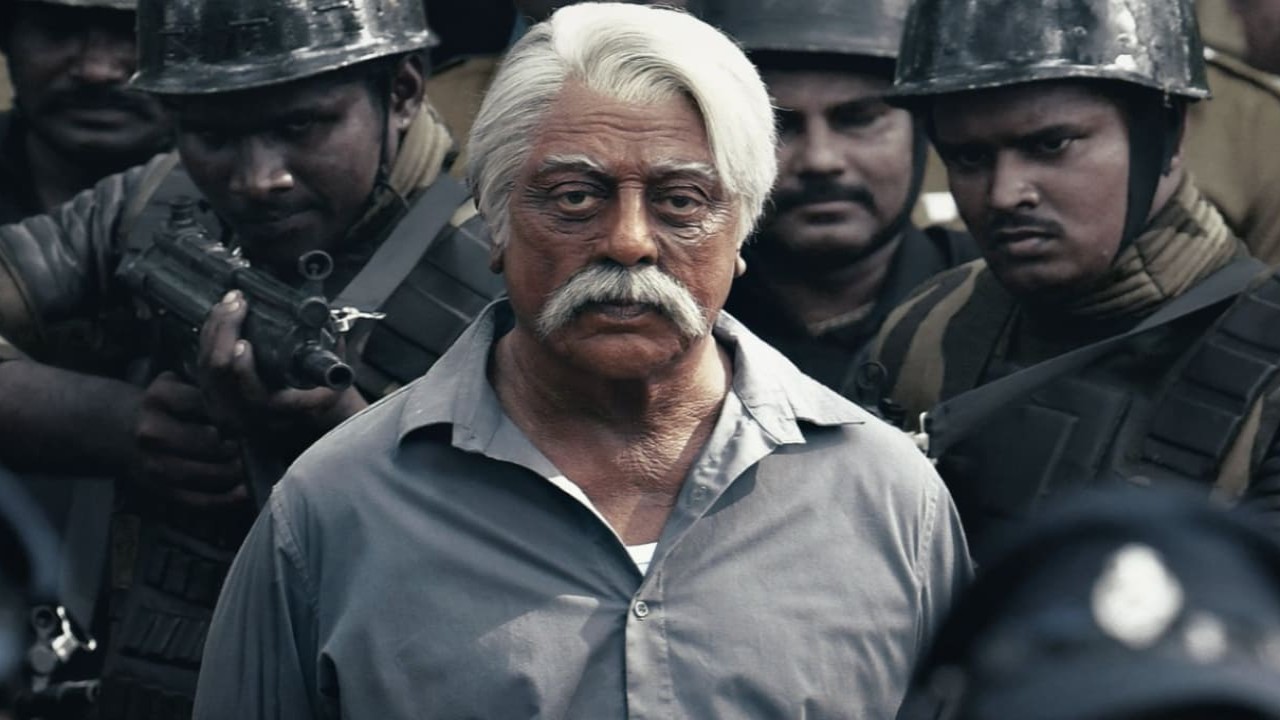Movie Reviews
Indian 2 Movie Review: Kamal Haasan becomes the saving grace in a half-baked screenplay with great concept and story | PINKVILLA

Kamal Haasan has finally arrived on the big screens with his much-awaited movie, Indian 2 directed by Shankar. The film marks the second installment in the Indian film series, serving as the sequel to the 1996 cult classic Indian.
Besides Ulaganayagan in the lead role, the movie also has actors Siddharth, S. J. Suryah, Rakul Preet Singh, Bobby Simha, Vivek, Priya Bhavani Shankar, Gulshan Grover, and many more in key roles. Additionally, the film also has Anirudh Ravichander helming the musical tracks and scores with certain scores by AR Rahman from the first part to be reused.
If you are planning to watch the Kamal Haasan movie in theaters near you, check out the Pinkvilla movie review of Indian 2 before you go!
The Plot of Indian 2
The story of Indian 2 starts in modern-day India where the people and society have once again dwindled down to their corrupt practices, creating a distress-filled land for the common people. Focusing on a group of youngsters who run a YouTube channel called Barking Dogs, the film showcases how the youth want to make India a better place.
However, despite having been effective with their voices and generating immense following on social media platforms, corruption only continues to rise. Now, going on the whims of their intuition, the group decides to start a trend on social networks, with “#ComeBackIndian.”
The rest of the film focuses on how Indian returns to his vigilante activities but this time issuing a two-track mission called Zero Tolerance.
The Good
Indian 2 features a high concept and a pan-Indian level threat that must be thwarted by Senapathy aka Indian with his vigilante methods and adept skills. The film’s biggest takeaway is seeing Kamal Haasan once again donning the iconic role and teaching everybody a lesson with his martial arts skill called Varma Kalai.
Besides Haasan, the only actor who managed to stand out as impressive and noteworthy was Siddharth who managed to be a saving grace in various instances. Coming to the story’s perspective, Indian 2 grasps onto openly abash modern-day social issues that are evident in various sectors of the country, even today.
Many instances that were used in the film were either inspirations of real-life tales we have heard from newspapers. This is where the comprehensive story manages to connect with the audience, making its way into a more technologically driven section of society.
The reflection on the ways of corruption creeping into various sectors was intricately crafted with us wanting to root for Indian and hope that one day the nation is rid of such heinous practices. Moreover, the films also featured the hypocritical nature of human beings in a day-to-day manner and how mob psychology kicks in whenever they suit it useful for themselves.
Moving ahead, the technical aspects of the film that served brilliantly in the movie were the grand visuals, production design, VFX, and the editing of the film. Despite having a dragged-out screenplay, the technicians like cinematographers Ravi Varman and R. Rathnavelu, editor Sreekar Prasad, and production designer T. Muthuraj.
Moreover, the songs and background scores by Anirudh Ravichander were thrilling and emotional in places. However, the themes by AR Rahman reused from the first installment stood out more prominently, making us nostalgic for the impact the former has on everyone.
The Bad
Indian 2 despite having a magnificent concept and huge star cast, falters in its ways due to a half-baked and outdated style of narration by Shankar. The ace director did not manage to capitalize on the vigilante trope and establish a well-rounded connection with the audience.
Even though the film started off in an exciting manner with the set-up for Indian’s arrival being more and more grander, the first half saw some sheepishly crafted sequences that only extended the viewing time and not the story, leaving our patience being tested.
In the second half, which is conveniently better out of the two halves, the movie still did not manage to create a euphoric feel towards the story or the lead character. The film also leaves several questions unanswered which may or may not be addressed in the third installment.
Moreover, the cat-and-mouse chase between Senapathy and the CBI still leaves behind a distasteful effect. What makes the film more annoying are the haphazard and amateurish dialogues. They do not even come close to the prominence of the first installment, written by the late Sujatha.
The half-baked screenplay of the movie would have been saved if only it wasn’t decided as a two-parter. Besides, the whole movie simply remains the catalyst that bridges the first and the third movie together.
The Performance
Kamal Haasan is undoubtedly the saving grace of the entire film. The movie strongly benefits from Ulaganayagan’s image from the first half itself. On the other hand, Siddharth played the role of Chitra Aravindan, the person who was the admin of the creative work.
However, no other actors including Rakul Preet Singh and SJ Surayah managed to exhibit their prominence in the film. Moreover, the movie also had actors Piyush Mishra and Gulshan Grover in minor roles, making us question their significance.
Despite all the other actors doing their best bid for the film, actress Priya Bhavani Shankar did not manage to appeal with her portrayal in the movie due to her stoic performance.
The Verdict
Kamala Haasan starrer Indian 2 is still an entertaining film that suffers from quite some pros and cons. The film trying to appeal to a younger audience seems to do random things for the sake of being meta. However, the true essence of the movie still has the potential to be uncovered, especially with the next installment.
Moreover, director Shankar’s use of vigilantism and the two-sided nature people have towards such heroes is commendable. In short, the film is a good watch for those who love socially just movies and is also essential for the direct sequel that also presents a historic origin for Senapathy.
PS. Those who decide to watch the film in theaters near you should stick around after the credits to see the trailer of Indian 3: War Mode, set to release in 2025.
Check out the trailer of Indian 2:
Comment down what you felt about Kamal Haasan starrer Indian 2, directed by Shankar.

Movie Reviews
Jamie David Langland’s ‘THE CELLAR’ (2025) – Movie Review – PopHorror

Psychological thrillers have to be my least favorite genre of all time. Rarely does a movie get by on just dialogue before I give up. The Cellar started out as such, and I was getting ready to lose interest. As I got further, I learned to appreciate the film. It’s a tough call, but I was fully entertained by the story. I really should learn a lesson and sit through these types of films more often.
Let’s get into the review to find out my real feelings.
Synopsis
A young girl wakes up in a dim underground cell, with no memory of how she got there. As she fights to escape, sinister secrets resurface, blurring the line between reality and her own buried traumas.
The Rundown
This is what turns me off to psychological thrillers. The lines between reality and horror don’t quite fit in my humble opinion. Whether it hides behind a horror facade or just outright rushes a story to fit into a 90-minute film. The stories require a lot more time to explain without confusion. Everything becomes complex and a think piece instead of just plain enjoyment.
The Cellar is the film that made me second-guess all the movies I have ever written about, where I say there’s no love in reality, so horror movies are an escape for me. I like to be entertained, not just a lack of understanding. The film does move slowly, and sometimes it confuses you, but in the end, you can piece together the story. It becomes simplified as the movie progresses. It brings a sense of clarity.

Hello Darkness
The dark setting also gave the movie more “pop”. You would think a dark cellar is redundant; however, the film definitely becomes more interesting and eerie as we look past the characters and experience flashbacks. The film has almost a Silent Hill vibe when it comes to explanation. That isn’t a bad thing at all, seeing as I have a Silent Hill tattoo and a small obsession with the games.
This is honestly what I picked up on after about 20 minutes of the movie. It is almost as if the film is hard to piece together on purpose. The film is like a tapeworm slowly creeping into your brain. It stays there and takes over your mindfulness. The film makes you feel a certain level of paranoia because, of course, this story could easily be reality. We have always had a way of looking at extreme religious intent and walking away quietly due to their stature in the community.
In The End
I didn’t find too many problems with The Cellar. The director passed the test on the film. Though I was about to give up hope as usual, I am extremely glad I gave it a longer shot than most. I would have missed out on a great film if I had told myself it wasn’t my interest, and being ready to talk down the entire film. I can’t argue about the significance, and Jamie David Langland’s directorial debut is outstanding. I look forward to seeing more films under their name as time progresses.
Movie Reviews
Tu Maza Kinara Movie Review: Suffers from poor direction and a story that goes nowhere

A story that focuses on the feelings for long enough to forget the facts. Tu Maza Kinara lacks a B-plot, leading to a disproportionate time spent on the minutia, while ignoring directional story progression.Suraj (Bhushan Pradhan), a perfectionist, is shattered when an accident results in the death of his wife (Ketaki Narayan) and the psychological mutism of his daughter (Keya Ingale). His perfect life now has to make space for his daughter’s special needs. The film poses next to no challenges for the main character, removing, as a result, any scope of development. Rife with inconsistencies, the film shows ‘psychological deafness’ being cured by a hearing aid and Suraj teaching his previously speech-abled daughter to pronounce Aai and Baba. The cinematography for the songs is quite possibly the only saving grace for Tu Maza Kinara. A film that has exemplary colour grade and a capable cast suffers at the hands of poor direction and a story that goes nowhere.
Movie Reviews
Christy

With Christy, David Michôd directs the story of Christy Martin, who single-handedly popularized female boxing from the early 1990s to the 2000s under the nickname coined by huckster-promoter Don King: “The Coal Miner’s Daughter.” Sydney Sweeney plays her in a performance that many critics have hailed as transformative. However, underneath frumpy clothes and an unconvincing wig, Sweeney never disappears into the role—it’s not, say, Linda Hamilton changing her physique to become a badass for Terminator 2: Judgment Day (1991). And as the standard sports movie template descends into a dark account of drugs and domestic abuse, Christy bears a curious similarity to Benny Safdie’s The Smashing Machine, another underwhelming sports biopic this year with a showy performance at the center. Produced in part by Sweeney, the whole production screams Oscar bait in the most cloyingly pedestrian way.
Raised in West Virginia, Christy, a sporto and closeted lesbian, clashes with her conservative, disapproving parents (Merritt Wever, Ethan Embry) who want her to see a priest to “get her straightened out.” Instead, she competes in an amateur boxing match “for fun,” with little knowledge of the sport: “All I knew was that I had to beat the shit outta that bitch before she beat me,” she remarks after her win. Soon, she meets a potential trainer, Jim (Ben Foster), whose creep factor is off the charts. Despite his being decades older and saddled with a beer belly and bad combover, Christy falls for him, ignoring his possessiveness and virulent anti-gay views while buying into his claims that he will make her “the greatest female fighter in the world.” Her mother certainly approves, believing Jim is her ticket to a “normal life.” Meanwhile, the viewer sees all the warning signs and awaits the inevitable fallout.
Michôd and Mirrah Foulkes wrote Christy, and they adhere to a typical sports movie structure, charting Christy’s meteoric rise to fame while ignoring the real boxer’s early-career losses and draws in favor of presenting a seemingly flawless winning streak. Cue the typical training and fight montages, here set to Young MC’s “Bust a Move.” While building a name for her, Jim goes full Vertigo (1958) and tells Christy to cut her hair so it’s not so “butch” and puts her in an all-pink getup so she looks “cute.” Before long, they sleep together, marry, move to Florida (where else?), and present themselves as an ambitious Average American couple. “I’m just a regular wife who happens to knock people out for a living,” Christy claims. She also shuts down any feminist take on her success with the press, pronouncing she doesn’t care about advancing other women or getting more money for them; she only cares about herself and her own success.
Christy’s brainwashing by Jim and her parents grows even more twisted when boxing doesn’t pay the bills, prompting him to arrange seedy hotel room fights for her with a 300-pound man for cash, and later, to record porn tapes with her for the underground market. That’s even after she becomes the first woman to fight on Pay-Per-View—a sequence shot in slow-mo and set to choral music, striking an ill-fitting tone compared to the rest of the movie. Additionally, very few of the boxing matches impress. They’re sloppily choreographed and shot by cinematographer Germain McMicking, who doesn’t bring any distinct visual flair to the proceedings. All the while, Christy is surrounded by people who don’t stand up for her, regardless of witnessing what’s obviously an abusive relationship. Her mother dismisses her claims that Jim has become violent (“You sound crazy,” she tells her daughter, in a maddening scene); she’s more concerned about keeping up appearances. Only Christy’s onetime opponent and later training partner—and later still, wife—Lisa Holewyne (Katy O’Brian) can see Christy’s true self enough to question the pretense.
“You make it real easy for people to dislike you,” Lisa observes. Indeed, she likes to talk smack in front of the press, calling out Lisa as a lesbian while passing as straight. That’s part of what makes her a success: performing for the camera. However, she doesn’t exactly endear herself to the viewer; I struggled to get on Christy’s side, which made the 135-minute runtime feel particularly long, especially in the repetitive second half. Although Jim’s domestic abuse, not only at home but also in the ring while sparring, gives us no choice but to empathize with her. Her only hope seems to be her former high school girlfriend, Rosie (Jess Gabor), who comes in and out of Christy’s life when the story needs her. Soon, drugs enter the mix, and the increasingly paranoid Jim reacts with a brutal attack that brings some finality to their marriage.
Sweeney once again never convinces in her performance, which is becoming a theme in her work, looking at last year’s Immaculate and this year’s Eden. Foster and Wever fare better, but like Sweeney, they’re all wearing equally silly wigs that render their performances unintentionally funny. Similar to The Smashing Machine, which was based on an earlier documentary and sanitized in its dramatization, viewers might be better off watching the documentary on this subject. Released on Netflix, Untold: Deal with the Devil (2021) tells Martin’s complex story without the typical overdone sports movie structure. Michôd, once a promising Australian filmmaker behind Animal Kingdom (2010) and The Rover (2014), appears to have lost his edge in recent years, starting with War Machine (2017) and The King (2019). With Christy, his approach is annoyingly stuffed with big speeches and dialogue that sounds like a Hallmark movie, and its generic, familiar quality never gives way to something worth the hype.
-

 Milwaukee, WI1 week ago
Milwaukee, WI1 week agoLongtime anchor Shannon Sims is leaving Milwaukee’s WTMJ-TV (Channel 4)
-

 News1 week ago
News1 week agoWith food stamps set to dry up Nov. 1, SNAP recipients say they fear what’s next
-

 Alabama1 week ago
Alabama1 week agoHow did former Alabama basketball star Mark Sears do in NBA debut with Milwaukee Bucks?
-

 Culture1 week ago
Culture1 week agoVideo: Tyler Mitchell Breaks Down Three Photos From His New Book
-

 Culture7 days ago
Culture7 days agoVideo: Dissecting Three Stephen King Adaptations
-

 Seattle, WA3 days ago
Seattle, WA3 days agoESPN scoop adds another intriguing name to Seahawks chatter before NFL trade deadline
-

 Seattle, WA1 week ago
Seattle, WA1 week agoFOX 13’s Aaron Levine wins back-to-back Jeopardy! episodes
-

 San Diego, CA1 week ago
San Diego, CA1 week agoAdd Nick Hundley, Ruben Niebla to list of Padres’ managerial finalists
















